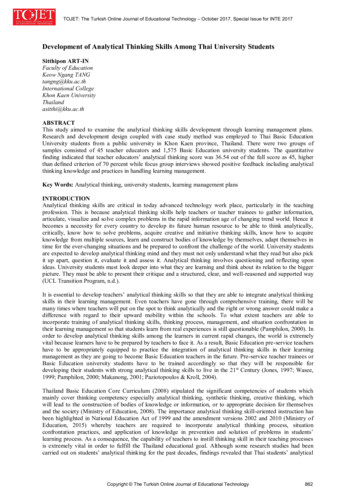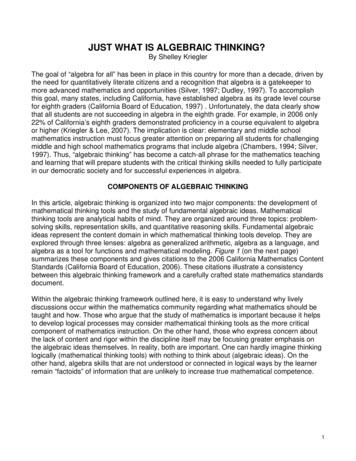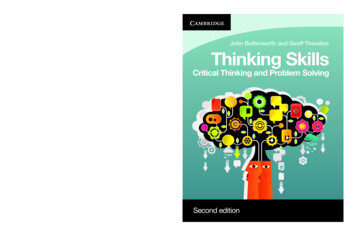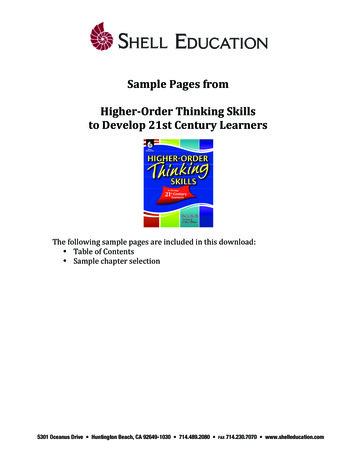
Transcription
TOJET: The Turkish Online Journal of Educational Technology – October 2017, Special Issue for INTE 2017Development of Analytical Thinking Skills Among Thai University StudentsSitthipon ART-INFaculty of EducationKeow Ngang TANGtangng@kku.ac.thInternational CollegeKhon Kaen UniversityThailandasitthi@kku.ac.thABSTRACTThis study aimed to examine the analytical thinking skills development through learning management plans.Research and development design coupled with case study method was employed to Thai Basic EducationUniversity students from a public university in Khon Kaen province, Thailand. There were two groups ofsamples consisted of 45 teacher educators and 1,575 Basic Education university students. The quantitativefinding indicated that teacher educators’ analytical thinking score was 36.54 out of the full score as 45, higherthan defined criterion of 70 percent while focus group interviews showed positive feedback including analyticalthinking knowledge and practices in handling learning management.Key Words: Analytical thinking, university students, learning management plansINTRODUCTIONAnalytical thinking skills are critical in today advanced technology work place, particularly in the teachingprofession. This is because analytical thinking skills help teachers or teacher trainees to gather information,articulate, visualize and solve complex problems in the rapid information age of changing trend world. Hence itbecomes a necessity for every country to develop its future human resource to be able to think analytically,critically, know how to solve problems, acquire creative and initiative thinking skills, know how to acquireknowledge from multiple sources, learn and construct bodies of knowledge by themselves, adapt themselves intime for the ever-changing situations and be prepared to confront the challenge of the world. University studentsare expected to develop analytical thinking mind and they must not only understand what they read but also pickit up apart, question it, evaluate it and assess it. Analytical thinking involves questioning and reflecting uponideas. University students must look deeper into what they are learning and think about its relation to the biggerpicture. They must be able to present their critique and a structured, clear, and well-reasoned and supported way(UCL Transition Program, n.d.).It is essential to develop teachers’ analytical thinking skills so that they are able to integrate analytical thinkingskills in their learning management. Even teachers have gone through comprehensive training, there will bemany times where teachers will put on the spot to think analytically and the right or wrong answer could make adifference with regard to their upward mobility within the schools. To what extent teachers are able toincorporate training of analytical thinking skills, thinking process, management, and situation confrontation intheir learning management so that students learn from real experiences is still questionable (Pamphilon, 2000). Inorder to develop analytical thinking skills among the learners in current rapid changes, the world is extremelyvital because learners have to be prepared by teachers to face it. As a result, Basic Education pre-service teachershave to be appropriately equipped to practice the integration of analytical thinking skills in their learningmanagement as they are going to become Basic Education teachers in the future. Pre-service teacher trainees orBasic Education university students have to be trained accordingly so that they will be responsible fordeveloping their students with strong analytical thinking skills to live in the 21st Century (Jones, 1997; Wasee,1999; Pamphilon, 2000; Makanong, 2001; Paziotopoulos & Kroll, 2004).Thailand Basic Education Core Curriculum (2008) stipulated the significant competencies of students whichmainly cover thinking competency especially analytical thinking, synthetic thinking, creative thinking, whichwill lead to the construction of bodies of knowledge or information, or to appropriate decision for themselvesand the society (Ministry of Education, 2008). The importance analytical thinking skill-oriented instruction hasbeen highlighted in National Education Act of 1999 and the amendment versions 2002 and 2010 (Ministry ofEducation, 2015) whereby teachers are required to incorporate analytical thinking process, situationconfrontation practices, and application of knowledge in prevention and solution of problems in students’learning process. As a consequence, the capability of teachers to instill thinking skill in their teaching processesis extremely vital in order to fulfill the Thailand educational goal. Although some research studies had beencarried out on students’ analytical thinking for the past decades, findings revealed that Thai students’ analyticalCopyright The Turkish Online Journal of Educational Technology862
TOJET: The Turkish Online Journal of Educational Technology – October 2017, Special Issue for INTE 2017thinking still failed to optimally be developed and seemed to reach only at certain limitation (Office of EducationStandard, Ministry of Education, 2006). The evaluation of students’ analytical thinking competence indicatedthat the achievement level requires improvement and is not satisfied (Nonglak, Suwimon, & Uayporn, 2004;Office of National Education Standards and Quality Assessment (ONESQA), 2007).ANALYTICAL THINKING THEORY (BLOOM, 1956)Researcher utilizes Benjamin Bloom and his associates’ discussions about analytical thinking as the theoreticalfoundation of this study. Their taxonomy for information processing skills (Bloom, 1956) is one of most widelycited sources for educational practitioners when it comes to teaching and assessing higher order thinking skillslike analytical thinking skills. Bloom’s taxonomy is hierarchical, with ‘comprehension’ at the bottom and‘evaluation’ at the top. The three highest levels (analysis, synthesis, and evaluation) are frequently said torepresent analytical thinking (Kennedy, Fisher, & Ennis, 1991).The benefit of this Bloom’s educational approach is that it is based on years of classroom experience andobservations of student learning (Sternberg, 1986). However, some have noted that the educational approach islimited in its vagueness. Concepts within the taxonomy lack the clarity necessary to guide instruction andassessment in a useful way (Ennis, 1985; Sternberg, 1986). Furthermore, the frameworks developed in educationhave not been tested as vigorously as those developed within philosophy or psychology (Sternberg, 1986). Onthis line of reasoning, researcher considers analytical thinking abilities according to past researchers of analyticalthinking typically agree on the specific abilities encompassed by the definition, which includes: Analyzing argument, claims, or evidence (Ennis, 1985; Facione, 1990; Halpern, 1998; Paul, 1992). Making inferences using inductive or deductive reasoning (Ennis, 1985; Facione, 1990; Paul, 1992;Willingham, 2007). Judging or evaluating (Case, 2005; Ennis, 1985; Facione, 1990; Lipman, 1988; Tindal & Nolet, 1995),and Making decisions or solving problems (Ennis, 1985; Halpern, 1998; Willingham, 2007).Other abilities or behaviors identified as relevant to analytical thinking include asking and answering questionsfor clarification (Ennis, 1985); defining terms (Ennis, 1985); identifying assumptions (Ennis, 1985; Paul, 1992);interpreting and explaining (Facione, 1990); reasoning verbally, especially in relation to concepts of likelihoodand uncertainty (Halpern, 1998); predicting (Tindal & Nolet, 1995), and seeing both sides of an issue(Willingham, 2007). According to Bloom, Engelhart, Furst, Hill, and Krathwohl (1979), the analysis is the majorcomponent of analytical thinking skills in this study. Therefore analytical thinking skills have to be operationallydefined into three types of analytical thinking namely analysis of elements, analysis of relationships, and analysisof organizational principles. At the first level, Basic Education university students are trained to break down thematerial into its constituent parts. This is followed by identification and classification process of the elements ofthe original material. At the second level, Basic Education university students are required to make explicitreports on the relationships among the elements, thus to determine their connections and interactions. The finallevel involves recognition of the organizational principles, the arrangement and structure, which hold togetherthe learning process as a whole.Analysis of elementsMost of the learning management may be conceived as composed of a large number of elements. Some of theseelements are explicitly stated or contained in the learning processes hence these elements can be recognized andclassified easily and relatively. However, there are also high possibilities that learners have difficulty inrecognizing the elements which are taught and identified by teachers. Learners may be unable to recognize theconclusions drawn by their teachers due to the analysis of elements are not explicitly stated by teachers. Thereare still many other elements during the learning management which are not clearly communicated, labeled oridentified by the teachers that may cause the students cannot do their thinking appropriately. On top of that,many of these elements may be of paramount importance in determining the nature of learning management untilthe stage that learners cannot detect and have difficulty in fully comprehending or evaluating the whole learning.Thus there are some unstated assumptions being made by teachers which can only infer from an analysis of aseries of statements within learning materials. It is also the value to the learner if he or she can detect the natureand function of particular statements including statements of fact, statements of value, and statements of contentin the learning management.The following are the analytical thinking skills related to an analysis of elements which should be considered tointegrate into learning objectives. Ability to recognize unstated assumptions. Skill in distinguishing facts from hypotheses.Copyright The Turkish Online Journal of Educational Technology863
TOJET: The Turkish Online Journal of Educational Technology – October 2017, Special Issue for INTE 2017 Ability to distinguish factual from normative statements.Skill in identifying motives and in discriminating between mechanisms of behavior with reference toindividuals and groups.Ability to distinguish a conclusion from statements which support it.Analysis of relationshipsHaving identified the different elements within a learning management, learner still has to have the ability todetermine some of the major relationships among the various parts of the learning process. Learners may need todetermine the relationship of the hypotheses to the evidence and in turn the relationship between the conclusionsand the hypotheses as well as the evidence. This type of analysis includes the relationship between differentkinds of evidence presented. In addition, analysis of relationships can be quite difficult when the essential partsof learning are contradicted between each other, which in turn hinder learners to expand, develop, or supporttheir learning progress. Most of this type of analysis may deal with the consistency of part to part, or element toelement or the relevance of elements or parts to the central idea.The following are the analytical thinking skills related to an analysis of relationships which should be consideredto integrate into learning objectives. Skills in comprehending the interrelationships among the ideas in a passage. Ability to recognize what particulars are relevant to the validation of a judgment. Ability to recognize which facts or assumptions are essential to the main learning or to the argument insupport of the learning. Ability to check the consistency of hypotheses with given information and assumption. Ability to distinguish cause-and-effect relationships from other sequential relationships. Ability to analyze the relations of statements in an argument, to distinguish relevant from irrelevantstatements. Ability to detect logical fallacies in arguments. Ability to recognize the causal relations and the importance details from historical account.Analysis of organizational principlesThe most complex and difficult level of analytical thinking is analyzing the structure and organization of thelearning process. It is rarely teachers will explicitly point out the organizational principles they have usedfrequently they may not be aware of the principles they have utilized. Thus their purpose, point of view, attitudeor general conception of the learning process may be discerned in their teaching and learners may be unable tofully comprehend or evaluate the learning until they have determined them. Similarly, some teachers select someform, pattern or structure to organize their arguments, evidence or other elements. This type of analyzesunderlying organizational qualities to assist in the comprehension as well as evaluation of the entire learningprocess. Frequently it is impossible to make an evaluation until the analytical thinking process has been done.The following are the analytical thinking skills related to an analysis of organizational principles which shouldbe considered to integrate into learning objectives. Ability to analyze, in a particular work of art, the relation of the materials and means of production tothe ‘elements’ and to the ‘organization’. Ability to recognize form and pattern in literacy or artistic works as a means of understanding theirmeaning. Ability to infer the teacher’s purpose, the point of view or traits of thought and feeling as exhibited inhis or her teaching. Ability to infer the teacher’s concept of science, philosophy, history, or his or her art as exemplified inhis or her practice. Ability to see the techniques used in persuasive materials, such as advertising, propaganda, etc. Ability to recognize the point of view or bias of a teacher in a historical account.LITERATURE REVIEWSResearcher explores the teaching ability of analytical thinking, as well as the instructional implications of theempirical literature on analytical thinking skills. Specific instructional recommendations for fostering thedevelopment of analytical thinking will be summarized as follows:Copyright The Turkish Online Journal of Educational Technology864
TOJET: The Turkish Online Journal of Educational Technology – October 2017, Special Issue for INTE 2017The teaching ability of analytical thinkingMany researchers argued that analytical thinking skills and abilities can be taught. For example, Halpern (1998)offers evidence of two instructional programs aimed at improving the analytical thinking skills and abilitiesof college students. In one of Halpern’s study, students who were taught general problem-solving skillsimproved on Piageting-inspired measures of cognitive development. In the other study, Halpern found thatcollege students instructed in a specific type of problem-solving strategy produced mental mathematicrepresentations that were more like those of experts than of novices. Kennedy et al. (1991) concluded thatinstructional interventions on students’ analytical thinking skills have generally shown positive results. In ameta-analysis of 117 empirical studies examining the impact of instructional interventions, in general, have apositive impact, with a mean effect size of 0.34. However, the distribution of effect sizes was highlyhomogeneous, with effect sizes varying dramatically by type of intervention and sample characteristics. Forexample, effect sizes for students in K-12 settings were higher than those observed among undergraduates.Specific instructional strategiesA number of past researchers have recommended using particular instructional strategies to encouragethe development of analytical thinking skills and abilities namely explicit instruction, collaborative orcooperative learning, modeling and constructivist techniques. For instance, many researchers have notedthat analytical thinking skills and abilities are unlikely to develop in the absence of explicit instruction(Abrami et al., 2008; Case, 2005; Facione, 1990; Halpern, 1998; Paul, 1992). Facione pointed out that thisexplicit instruction should also attend to the dispositional or affective component of analytical thinking.Proponents of collaborative or cooperative learning include Thayer-Bacon (2000), who emphasizes theimportance of students’ relationships with others in developing analytical thinking skills. Bailin, Case,Coombs, and Daniels (1999) argued that analytical thinking involves the ability to respond constructivelyto others during group discussion, which implies interacting in pro-social ways by encouraging andrespecting the contributions of others. Similarly, Heyman (2008) indicated that social experiences can shapestudents’ reasoning about the credibility of claims. On top of that, Abrami et al. (2008) found a small butpositive and significant effect of collaborative learning approaches on analytical thinking.Besides, teachers are urged to use constructivist learning methods, characterized as more student-centeredthan teacher-centered (Bonk & Smith, 1998; Paul, 1992). Constructivist instruction is less structured thantraditional instruction, amplifying students’ roles in their own learning and de-emphasizing the role ofthe teacher. Educators should model analytical thinking in their own instruction by making theirreasoning visible to students.RESEARCH AIMSThe major aim of this study was to investigate the analytical thinking skills in learning management forBasic Education students. Researchers seek to investigate: (i) Developmental process of integration ofanalytical thinking skills by Basic Education teacher educators while managing learning process throughtraining; (ii) Teacher educators’ achievement in integrating analytical thinking skills in learning managementafter training by evaluating their learning management plans; (iii) Basic Education university students’analytical thinking skills and satisfaction level after receiving intervention, and (iv) teacher educators’feedback after implementation of learning management plans.METHODResearchers utilized Research and Development design to develop analytical thinking of Thai Basic Educationuniversity students from a public university located in Khon Kaen province, Thailand. Researcher aimedto develop pre-service teachers’ competency to emphasize analytical thinking in their learning management.Case study research design was utilized. Case study research intensively investigates a small set of cases,focusing on many details within each case and context. In short, it examines both details within each case’sinternal features as well as the surrounding situations. Case study enables researchers to link the micro level thatis undergraduate program pre-service university students to the macro level, or large-scale structures andprocesses (Vaughan, 1992). The logic of the case study is to demonstrate a causal argument about how generalsocial forces shape and produce results in particular setting (Walton, 1992).The research and development procedure was used as a guideline for the study and conducted in two phases. Thefirst phase was to develop educators’ learning management through training. Researchers worked withthe sample group to identify problems and to find effective ways of solving them. Several meetings wereorganized in order to make the objectives of the project clear to the participants who are teacher educators and todiscuss a training workshop which emphasizes on analytical thinking learning management. This isfollowed by evaluation of the results of the development.Copyright The Turkish Online Journal of Educational Technology865
TOJET: The Turkish Online Journal of Educational Technology – October 2017, Special Issue for INTE 2017The following was the research procedure: (i) Researchers held a meeting with research working group toexplain the objectives for integrating analytical thinking skills in learning management, the training procedures,evaluating procedures, training schedule and value, and the roles as well as duties of research working group; (ii)Researchers invited four experts in the areas of development of analytical thinking skills and learningmanagement to conduct a comprehensive training workshop; (iii) Subsequently researchers held severalmeetings with the four experts for common understanding of the use of the learning management model todevelop analytical thinking (Sitthipon Art-in, 2011) and the planning of the training; (iv) A total of 45 teachereducators were volunteering to participate in training. These teacher educators were trained to develop learningmanagement from October 20 to 21, 2014 at the Faculty of Education, a public university in Khon Khen city,Thailand; (v) The training activities emphasized three main competencies namely the basic knowledge ofanalytical thinking, training analytical thinking process, and learning management model to develop analyticalthinking; (vi) By the end of the training, evaluation was carried to measure the outcomes of the training; (vii)Teacher educators’ analytical thinking skills were tested and their learning management plans with analyticalthinking skills integration were evaluated by the end of the training, and (viii) teacher educators were assigned toconstruct two analytical thinking learning management plans for their teaching within duration of four weeks andsubmitted their plans for evaluation.The second phase of this study was to construct learning management plans, implementing learningmanagement, and measure feedback from Basic Education university students and teacher educators. Thefollowing steps had been taken: (i) Researchers and the 45 trained teacher educators attended a workshop fromJanuary 18 to 19, 2014 at Faculty of Education, a public university at Khon Kaen city, Thailand; (ii) Thisworkshop mainly aimed to plan and draft the learning management plans with integration of analytical thinkingskills based on the learning model; (iii) The Learning Management Model emphasizing analytical thinking(Sitthipon Art-in, 2011) has six steps namely orientation, presentation of learning task, practice of analyticalthinking individually or small group, presentation and discussion of ideas, and conclusion; (iv) A total of 12learning management plans had been developed and would be implemented for 12 hours per one class for eachcohort for a period as one semester; (v) Teacher educators who applied the 12 learning management plans wereresponsible for developing analytical thinking skills of their Basic Education university students in theirrespective classes; (vi) By the end of the 12 hours learning management processes, the Basic Educationuniversity students were tested on their analytical thinking skills; (vii) The test results of Basic Educationuniversity students were analyzed and interpreted by comparing with the defined criterion as 70 percent, and(viii) researchers interviewed teacher educators to collect their feedback after implementing learningmanagement plans.The target group in this study consisted of two groups of samples. The first target group consisted of 45 teachereducators from undergraduate programs in Khon Kaen city, Northeast of Thailand utilizing purposive samplingtechnique. All the 45 teacher educators agreed to participate in designing learning management plans thatemphasizing analytical thinking skills. The second target group comprised of 1,575 Basic Education universitystudents from nine undergraduate programs. This group of students has to attend the 12 hours learningmanagement process for the first semester of 2014.The instruments utilized in this study were learning management plans, evaluation tools, and interview protocolfor teacher educators. There are two types of evaluation tools. The first type of evaluation tool is a 45four-choice items test used to evaluate teacher educators’ analytical thinking skills after the training. It had beentested for content validity with the Index-Objective Congruence (IOC) as within 0.80 to 1.00, item difficultylevel as within 0.24 to 0.72, item discrimination factor as 0.35 to 0.86, and reliability value as 0.86. The secondtype of evaluation tool is a 16 five-scale rating items used to evaluate analytical thinking of the Basic EducationUniversity students.RESULTSResults of this study are presented in accordance with the research aims that are indicated above. The initialfinding is the result of analytical thinking test of teacher educators and evaluation of learning management plansafter training. This is followed by the Basic Education university students’ achievement test on analyticalthinking skills according to defined criteria. Finally, results of feedback from teacher educators afterimplementing learning management. Results were organized according to quantitative and qualitative methods.Quantitative resultsThe result indicates that teacher educators’ analytical thinking score was 36.54 out of the full score as 45(standard deviation 3.68) after training. This shows that teacher educators’ analytical thinking skills werehigher than the defined criterion of 70 percent. Besides, the result of evaluation of their learning managementCopyright The Turkish Online Journal of Educational Technology866
TOJET: The Turkish Online Journal of Educational Technology – October 2017, Special Issue for INTE 2017plans which emphasized analytical thinking skill after training was at ‘good’ and ‘very good’ quality level. Asindicated in Table 1, a total of 34 and 11 teacher educators are able to construct the ‘very good’ and ‘good’quality learning management plans respectively after training. On the other hand, the average score in analyticalthinking skills for the overall Basic Education University students after the intervention was 78.19 percent whichwas higher than the defined criterion of 70 percent. The percentage for the nine programs ranged from 76.95 to79.51.Table 1. Evaluation on teacher educators after trainingQuality level of learning management planFrequencyVery good34Good11Mean score of analytical thinking test ( 36.54Standard deviation (SD) 3.68Percentage75.5624.44Additionally, the result indicates that Basic Education university students were satisfied with the learningmanagement with integration of analytical thinking skills. The result of evaluation on their satisfaction level afterthe intervention was found to be encouraging, mean score ranged from 4.59 to 4.63. As a result, Basic Educationuniversity students’ achievement was higher than the defined criterion thus they were satisfied with the learningmanagement.Qualitative resultsThe qualitative findings were found to support the quantitative findings above. From the focus group interviewwith teacher educators, researchers found that the training has been successfully assisted teacher educators toacquire better understanding and knowledge, be able to practice self-analytical thinking, be able to write learningmanagement plans, and confidence to handle effective learning management. These points were explicitlypointed out by teacher educator 1 to teacher educator 11 (T1, T2, T3, T4, T5, T6, T7, T8, T9, T10, and T11).“I acquire knowledge a clear understanding of analytical thinking.” (T2)“The analysis of elements, analysis of relationships, and analysis of organization principles includinglearning management model is very useful to emphasize analytical thinking.” (T4)“I will use the learning management to develop analytical thinking of my students.” (T1)“I now able to practice the process of self-analytical thinking.” (T3)“As a result, I can practice a higher analytical thinking to my students.” (T8)“And I will apply learning activities to develop my students’ analytical thinking” (T5)“I have the practice to write learning management lesson plans that emphasize analytical thinking.” (T6)“I always discuss with my friends and speakers of the training, I find myself good at writing learningmanagement plans now.” (T7)“Training makes me possible to write effective learning management plans” (T9)“I am now very confident that I can handle learning management that emphasizing analytical thinking todevelop analytical thinking of students effectively.” (T10)“I will apply the knowledge gained from the training to learning management to develop analyticalthinking of students.” (T11)DISCUSSIONFindings of this study show that teacher educators’ analytical thinking achievement was improved after thetraining. This finding corresponds to Khaemmane (2003), Baldwin (1984), National Council of Social StudiesNCSS (1989) ideas. According to Khaemmanee, individual thinking process could be developed. On the otherhand, statement from Baldwin and National Council of Social Studies indicated that there were three importantactivities namely provision of basic knowledge in analytical thinking, analytical thinking process, and provisionof knowledge on the designed patterns of procedures for learning management that emphasizes analyticalthinking are able to train them to think and understand the thinking process. Results from this study revealed thatteacher educators acquired knowledge and clear understanding related to analytical thinking after the training.They found themselves are able to practice thinking analytically, exchange knowledge, share ideas with otherteacher educators, and enable to know and understand the patterns or procedures of learning management modelafter the training. These teacher educators also had the chance to practice designing learning management plansthat involve analytical thinking. They presented the plans and discussed their opinions and share
component of analytical thinking skills in this study. Therefore analytical thinking skills have to be operationally defined into three types of analytical thinking namely analysis of elements, analysis of relationships, and analysis of organizational principles. At the first level, Basic Education university students are trained to break down the










